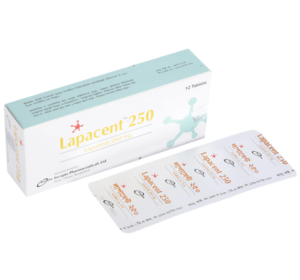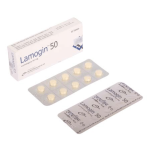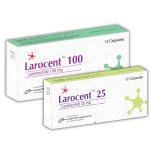Lapacent 250(Lapatinib)

Therapeutic Group: Oncology
Presentation
Lapacent 250: Each tablet contains Lapatinib ditosylate monohydrate INN equivalent to Lapatinib 250 mg
Description
Lapatinib is a 4-anilinoquinazoline kinase inhibitor of the intracellular tyrosine kinase domains of both Epidermal Growth Factor Receptor (EGFR [ErbB1]) and of Human Epidermal Receptor Type 2 (HER2 [ErbB2]) receptors (estimated Kiapp values of 3nM and 13nM, respectively) with a dissociation half-life of ≥ 300 minutes. Lapatinib inhibits ErbB-driven tumor cell growth in vitro and in various animal models. Hormone receptor-positive breast cancer cells (with ER [Estrogen Receptor] and/or PgR[Progesterone Receptor]) that co-express the HER2 tend to be resistant to established endocrine therapies. Similarly, hormone receptor-positive breast cancer cells that initially lack EGFR or HER2, up-regulate these receptor proteins as the tumor becomes resistant to endocrine therapy.
Indications
Lapatinib, a kinase inhibitor, is indicated in combination with Capecitabine, for the treatment of patients with advanced or metastatic breast cancer whose tumors overexpress HER2 and who have received prior therapy including an Anthracycline, a taxane, and Trastuzumab.
Limitation of Use: Patients should have disease progression on Trastuzumab prior to initiation of treatment with Lapatinib in combination with Capecitabine. Letrozole for the treatment of postmenopausal women with hormone receptor-positive metastatic breast cancer that overexpresses the HER2 receptor for whom the hormonal therapy is indicated. Lapatinib in combination with an aromatase inhibitor has not been compared to the Trastuzumab-containing chemotherapy regimen for the treatment of metastatic breast cancer.
Dosage & Administration
The recommended dosage of Lapatinib for advanced or metastatic breast cancer is
1,250 mg (5 tablets) given orally once daily on Days 1-21 continuously in combination
with capecitabine 2,000 mg/m2/day (administered orally in 2 doses approximately 12
hours apart) on Days 1-14 in a repeating 21-day cycle.
The recommended dose of Lapatinib for hormone receptor-positive, HER2positive
metastatic breast cancer is 1,500 mg (6 tablets) given orally once daily continuously in
combination with Letrozole. When Lapatinib is co administered with Letrozole, the
recommended dose of Letrozole is 2.5 mg once daily.
• Lapatinib should be taken at least one hour before or one hour after a meal.
However, Capecitabine should be taken with food or within 30 minutes a fter food.
• Lapatinib should be taken once daily. Do not divide daily doses of Lapatinib
• Modify dose for cardiac and other toxicities, severe hepatic impairment, diarrhea, and
CYP3A4 drug interactions
Side Effects
The most common (>20%) adverse reactions during treatment with Lapatinib plus
Capecitabine were diarrhea, palmar-plantar erythrodysesthesia, nausea, rash, vomiting,
and fatigue. The most common (>20%) adverse reactions during treatment with Lapatinib
plus Letrozole were diarrhea, rash, nausea, and fatigue.
Precautions
• Decreases in left ventricular ejection fraction (LVEF) have been reported. Normal
LVEF should be confirmed before starting Lapatinib and continue evaluations during
treatment
• Lapatinib has been associated with hepatotoxicity. Liver function tests should be
monitored before initiation of treatment, every 4 to 6 weeks during treatment, and as
clinically indicated. If patients experience severe changes in liver function tests Lapatinib
should be discontinued and should not be restarted
• Dose reduction in patients with severe hepatic impairment should be considered
• Diarrhea, including severe diarrhea, has been reported during treatment. Should be
managed with anti-diarrheal agents, and fluids and electrolytes should be replaced if
severe
• Lapatinib has been associated with interstitial lung disease and pneumonitis.
Lapatinib should be discontinued if patients experience severe pulmonary symptoms
• Lapatinib may prolong the QT interval in some patients. ECG and electrolyte
monitoring should be considered.
• Severe cutaneous reactions have been reported. Lapatinib should be discontinued if
life-threatening reactions are suspected
• Fetal harm can occur when administered to a pregnant woman. Women should be
advised not to become pregnant when taking Lapatinib
Use in Pregnancy & Lactation
Pregnancy Category D:
Based on animal data, Lapatinib can cause fetal harm when administered to a pregnant woman. There are no adequate and well-controlled studies with Lapatinib in pregnant women. Women should be advised not to become pregnant when taking Lapatinib. If this drug is used during pregnancy, or if the patient becomes pregnant while taking this drug, the patient should be apprised of the potential hazard to the fetus. It is not known whether Lapatinib is excreted in human milk. Because many drugs are excreted in human milk and because of the potential for serious adverse reactions in nursing infants from Lapatinib, a decision should be made whether to discontinue nursing or to discontinue the drug, taking into account the importance of the drug to the mother.
Pediatric Use
The safety and effectiveness of Lapatinib in pediatric patients have not been established.
Geriatric Use
No overall differences in safety or effectiveness were observed between elderly subjects and younger subjects, and other reported clinical experience has not identified the differences in responses between the elderly and younger patients, but greater sensitivity of some older individuals cannot be ruled out.
Drug Interaction
Effects of Lapatinib on Drug Metabolizing Enzymes and Drug Transport Systems:
Lapatinib inhibits CYP3A4, CYP2C8, and P-glycoprotein (P-gp, ABCB1) in vitro at clinically relevant concentrations and is a weak inhibitor of CYP3A4 in vivo. Caution should be exercised and dose reduction of the concomitant substrate drug should be considered when dosing Lapatinib concurrently with medications with narrow therapeutic
windows that are substrates of CYP3A4, CYP2C8, or P-gp.
Midazolam: Following co administration of Lapatinib and Midazolam (CYP3A4 substrate), 24-hour systemic exposure (AUC) of orally administered Midazolam increased 45%, while 24-hour AUC of intravenously administered Midazolam increased 22%.
Paclitaxel: In cancer patients receiving Lapatinib and Paclitaxel (CYP2C8 and P-gp substrate), 24-hour systemic exposure (AUC) of Paclitaxel was increased by 23%.
Digoxin: Following co-administration of Lapatinib and Digoxin (P-gp substrate), systemic AUC of an oral Digoxin dose increased approximately 2.8-fold. Serum Digoxin
concentrations should be monitored prior to the initiation of Lapatinib and throughout co-administration. If Digoxin serum concentration is >1.2 ng/mL, the Digoxin dose should be reduced by half. Drugs That Inhibit or Induce Cytochrome P450 3A4 Enzymes Lapatinib undergoes extensive metabolism by CYP3A4, and concomitant administration of strong inhibitors or inducers of CYP3A4 alter Lapatinib concentrations significantly. Dose adjustment of Lapatinib should be considered for patients who must receive concomitant strong inhibitors or concomitant strong inducers of CYP3A4 enzymes
Ketoconazole: In healthy subjects receiving Ketoconazole, a CYP3A4 inhibitor, at 200 mg twice daily for 7 days, systemic exposure (AUC) to Lapatinib was increased to approximately 3.6-fold of control and half-life increased to 1.7-fold of control.
Carbamazepine: In healthy subjects receiving the CYP3A4 inducer, Carbamazepine, at 100 mg twice daily for 3 days and 200 mg twice daily for 17 days, systemic exposure
(AUC) to Lapatinib was decreased by approximately 72%.
Drugs That Inhibit Drug Transport Systems:
Lapatinib is a substrate of the efflux transporter P glycoprotein (P-gp, ABCB1). If Lapatinib is administered with drugs that inhibit P-gp, increased concentrations of Lapatinib are likely, and caution should be exercised.
Commercial Pack
Lapacent 250: Each box contains 3 blister strips of 12 tablets.
Lapacent 250: Each bottle contains 30 tablets.



